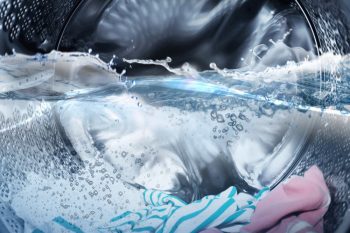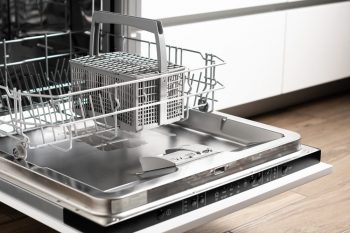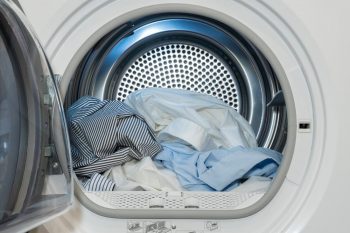
Condensation drying is a feature found in many modern dishwashers, but what exactly is it and how does it work? This article aims to provide you with an in-depth understanding of this dishwasher function, its benefits, drawbacks, and maintenance tips.
Condensation drying in a dishwasher is a feature that uses the temperature difference between the hot dishes and the cooler stainless steel interior of the dishwasher to facilitate the drying process. After the dishes are rinsed with hot water, the moist air inside the dishwasher condenses into water droplets when it comes into contact with the cooler stainless steel walls. These droplets then slide down the walls and are drained out. This method is energy-efficient and hygienic, as it doesn’t require a heating element and keeps the drying process enclosed.
The Principle Behind Condensation Drying
Condensation drying operates on a simple principle: it leverages the temperature difference between the hot dishes and the cooler stainless steel interior of the dishwasher to facilitate the drying process. At the end of the cleaning cycle, the dishwasher rinses the dishes with hot water, making them very hot. The stainless steel tub cools faster than the dishes, creating a temperature difference. When the moist air inside the dishwasher comes into contact with the cooler stainless steel walls, condensation occurs, turning the moist air into water droplets. These water droplets then slide down the walls and are drained out of the dishwasher. This method is energy-efficient and hygienic, as it does not require a heating element and keeps the drying process enclosed.
Condensation Drying vs. Traditional Drying Methods
Traditional drying methods, such as heated air drying, use a heating element and a fan to heat the air and distribute it evenly throughout the dishwasher, evaporating the moisture on the dishes. This method can be energy-consuming and may cause warping of plastic dishware and wooden utensils due to the high heat.
On the contrary, condensation drying is more energy-efficient and hygienic. It works by rinsing the dishes with hot water at the end of the cleaning cycle, making the dishes very hot. The stainless steel tub of the dishwasher cools faster than the dishes, causing condensation to occur when the moist air inside the dishwasher comes into contact with the cooler stainless steel tub. This process is gentle on plastics and does not use a heating element, making it safer for various types of dishware.
Key Benefits of Condensation Drying
- Energy efficiency: Condensation drying uses hot water to rinse the dishes at the end of the wash cycle, which is more energy-efficient than using a heating element to force hot air for drying.
- Hygiene: This drying method is considered more hygienic because it does not require a heating element, which can potentially harbor bacteria.
- Safety for dishes and the machine: Condensation drying is gentler on your dishes and dishwasher, as it does not expose them to high temperatures from a heating element.
- Compatibility with plastics: Since condensation drying does not use a heating element, it is safer for drying plastic items, which can be sensitive to high temperatures.
- Reduced noise: Dishwashers with condensation drying tend to be quieter, as they do not require fans or heating elements to dry the dishes.
Potential Drawbacks and Limitations
Like any technology, condensation drying is not without its drawbacks:
- Ineffective drying of plastic items: Condensation drying does not work as well with plastic items, as they do not retain heat well. This can result in plastic dishes and containers remaining wet after the drying cycle.
- Longer drying times: Condensation drying can take longer than traditional heat drying methods, which may not be ideal for those who need their dishes dried quickly.
- Potential for water spots: Although using rinse aid can help reduce water spots on glassware and improve overall drying performance, some users may still experience water spots on their dishes.
- Incomplete drying: Even with condensation drying, dishes may not always be completely dry to the touch after the cycle.
Maintaining the Condensation Drying Feature
To maintain the condensation drying feature, use a rinse aid to help water roll off the dishes and allow them to dry faster. Load dishes properly and avoid overloading the dishwasher. Regularly check and clean the filters, spray arms, and other components as needed. Choose the right drying cycle and keep the dishwasher in a well-ventilated area.
Buying a Dishwasher with a Condensation Drying Feature
When buying a dishwasher with a condensation drying feature, look for energy efficiency, drying performance, stainless steel tub, rinse aid compatibility, special drying options, and brand reputation and reviews.
In conclusion, condensation drying is a beneficial feature found in many modern dishwashers. While it may not be perfect, it offers several advantages, making it a worthy consideration when purchasing a new dishwasher.
Frequently Asked Questions
What is a rinse aid and why is it beneficial for condensation drying?
A rinse aid is a dishwasher additive that helps reduce the surface tension of water, making it easier for water to slide off the dishes and glassware. This helps dishes dry faster and prevents water spots. It’s particularly beneficial for condensation drying as it aids in faster water evaporation and improves the overall drying performance.
Are there specific dishwashers brands known for their condensation drying feature?
Yes, several brands are known for their excellent condensation drying feature. These include, but are not limited to, Bosch, Miele, and Siemens. It’s always recommended to read product reviews and specifications before making a purchase decision.
Can I use the condensation drying feature for all types of dishes?
While the condensation drying process is gentle and safe for most types of dishes, it may not be as effective on plastic items. Plastics do not retain heat as well as other materials, which can result in them remaining wet after the drying cycle.
Is there a way to improve the drying performance of my dishwasher with condensation drying?
Yes, there are several ways to improve the drying performance. These include using a rinse aid, loading the dishes properly, and not overloading the dishwasher. Regular maintenance of the dishwasher, including cleaning filters and spray arms, can also enhance its performance.
What are some alternatives to condensation drying?
Heated drying is a common alternative to condensation drying. This process uses an electric heating element to heat the air inside the dishwasher, which then evaporates the moisture on the dishes. However, this method consumes more energy and can potentially warp plastic dishware and wooden utensils.












